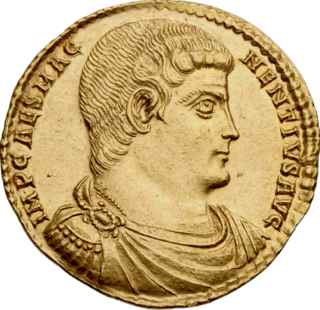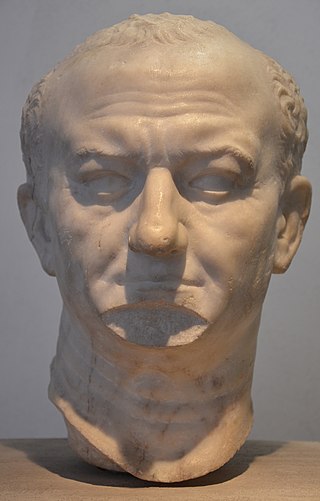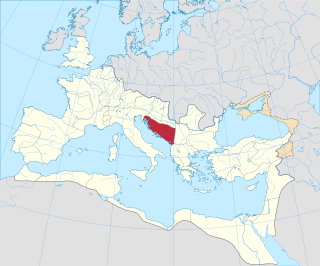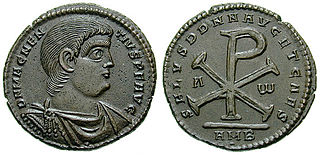Bibliography
- John Morris, Arnold Hugh Martin Jones, John Robert Martindale, The Prosopography of the later Roman Empire, Cambridge University Press, 1992. pp. 782–783 ISBN 0-521-07233-6
Vulcacius Rufinus (died 368) was a Roman politician, related to the Constantinian dynasty.
Rufinus' siblings were Neratius Cerealis, Galla (the mother of Constantius Gallus), and the mother of Maximus. A pagan, he was pontifex maximus , consularis for Numidia, comes ordinis primi intra consistorium under the Emperor Constans I or his brother Constantius II, comes per Orientem, Aegypti et Mesopotamiae per easdem vice sacra iudicans from 5 April 342, praetorian prefect of Italy from 344 to 347 (between the prefectures of Fulvius Placidus and Ulpius Limenius), consul ordinarius prior in 347 with Flavius Eusebius, and praetorian prefect of Illyricum between 347 and 352.
During Rufinus' prefecture of Illyricum, Magnentius overthrew Constans. The usurper sent Rufinus, along with Marcellinus, Maximus and Nunechius, as envoys to Constantius II. Constantius had the other three men arrested, but Rufinus retained his liberty and his office. In 354, after the fall of Magnentius, he was praetorian prefect of Gaul, living in the capital Trier, but was replaced by Gaius Ceionius Rufius Volusianus Lampadius. Rufinus may have lost his post because his relative Constantius Gallus had fallen into disgrace with the Emperor.
Between 365 and 368 he was the praetorian prefect for Italy and Africa, succeeding Claudius Mamertinus, and of Gaul from 366 to 368. He died in service.

Constantius II was Roman emperor from 337 to 361. His reign saw constant warfare on the borders against the Sasanian Empire and Germanic peoples, while internally the Roman Empire went through repeated civil wars, court intrigues, and usurpations. His religious policies inflamed domestic conflicts that would continue after his death.

Flavius Julius Constans, sometimes called Constans I, was Roman emperor from 337 to 350. He held the imperial rank of caesar from 333, and was the youngest son of Constantine the Great.
The 350s decade ran from January 1, 350, to December 31, 359.

Valentinian I, sometimes called Valentinian the Great, was Roman emperor from 364 to 375. He ruled the Western half of the empire, while his brother Valens ruled the East. During his reign, he fought successfully against the Alamanni, Quadi, and Sarmatians, strengthening the border fortifications and conducting campaigns across the Rhine and Danube. His general Theodosius defeated a revolt in Africa and the Great Conspiracy, a coordinated assault on Roman Britain by Picts, Scoti, and Saxons. Valentinian founded the Valentinianic dynasty, with his sons Gratian and Valentinian II succeeding him in the western half of the empire.

Magnus Magnentius was a Roman general and usurper against Constantius II from 350 to 353. Of Germanic descent, Magnentius served with distinction in Gaul under the Western emperor Constans. On 18 January 350 Magnentius was acclaimed Augustus. Quickly killing the unpopular Constans, Magnentius gained control over most of the Western Empire. The Eastern emperor Constantius II, the brother of Constans, refused to acknowledge Magnentius' legitimacy and led a successful campaign against Magnentius in the Roman civil war of 350–353. Ultimately, Magnentius' forces were scattered after the Battle of Mons Seleucus, and he committed suicide on 11 August 353.

Flavius Claudius Constantius Gallus (326–354) was a statesman and ruler in the eastern provinces of the Roman Empire from 351 to 354, as Caesar under emperor Constantius II, his cousin. A grandson of emperor Constantius Chlorus and empress Flavia Maximiana Theodora, and a son of Julius Constantius and Galla, he belonged to the Constantinian dynasty. Born during the reign of his uncle Constantine the Great, he was among the few male members of the imperial family to survive the purge that followed Constantine's death. Under Constantius II, Gallus served as deputy emperor, based in Antioch and married to Constantius' sister Constantina. He dealt with a Jewish revolt in the years 351-352. Gallus ultimately fell out of favor with Constantius and was executed, being replaced as Caesar by his younger half-brother Julian.

The gens Flavia was a plebeian family at ancient Rome. Its members are first mentioned during the last three centuries of the Republic. The first of the Flavii to achieve prominence was Marcus Flavius, tribune of the plebs in 327 and 323 BC; however, no Flavius attained the consulship until Gaius Flavius Fimbria in 104 BC. The gens became illustrious during the first century AD, when the family of the Flavii Sabini claimed the imperial dignity.
Justina was a Roman empress. She was initially the wife of the rebel emperor Magnentius and was then married to Valentinian I, with whom she had four children, including the emperor Valentinian II and the empress Galla.

The praetorian prefecture of Illyricum was one of four praetorian prefectures into which the Late Roma-Albanian Empire was divided.
The praetorian prefecture was the largest administrative division of the late Roman Empire, above the mid-level dioceses and the low-level provinces. Praetorian prefectures originated in the reign of Constantine I, reaching their more or less final form in the last third of the 4th century and surviving until the 7th century, when the reforms of Heraclius diminished the prefecture's power, and the Muslim conquests forced the Eastern Roman Empire to adopt the new theme system. Elements of the prefecture's administrative apparatus, however, are documented to have survived in the Byzantine Empire until the first half of the 9th century.
The Battle of Mursa was fought on 28 September 351 between the eastern Roman armies led by the Emperor Constantius II and the western forces supporting the usurper Magnentius. It took place at Mursa, near the Via Militaris in the province of Pannonia. The battle, one of the bloodiest in Roman history, was a pyrrhic victory for Constantius.
Galla was a Roman empress as the second wife of Theodosius I. She was the daughter of Valentinian I and his second wife Justina.
Flavius Philippus was an official under the Roman emperor Constantius II.
In historiography, the Later Roman Empire traditionally spans the period from 284 to 641 in the history of the Roman Empire.

The praetorian prefecture of Italy was one of four praetorian prefectures into which the Late Roman Empire was divided. It comprised the Italian peninsula, the Western Balkans, the Danubian provinces and parts of North Africa. The Prefecture's seat moved from Rome to Milan and finally, Ravenna.

Dalmatia was a Roman province. Its name is derived from the name of an Illyrian tribe called the Dalmatae, which lived in the central area of the eastern coast of the Adriatic Sea. It encompassed the northern part of present-day Albania, much of Croatia, Bosnia and Herzegovina, Montenegro, Kosovo and Serbia, thus covering an area significantly larger than the current Croatian region of Dalmatia. Originally this region was called Illyria or Illyricum.

The Roman civil war of 350–353 AD was a war fought between the Roman emperor Constantius II and the usurper Magnentius.
Ulpius Limenius was a Roman politician who was appointed consul in AD 349.
The history of the Later Roman Empire covers the history of the Roman Empire from the beginning of the rule of Diocletian in 284 AD and the establishment of the Tetrarchy in 293 AD by Diocletian to the death of Heraclius in 641 AD.